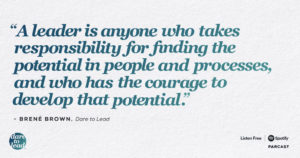What It Means to Lead with Purpose
What you’ll learn about purpose-driven leadership:
- Today, leading a company means so much more than making a profit
- Leaders need to encourage their teams to put the customer at the center of everything they do
- They also need to invest in their teams and communities in order to provide more value
- Marketing can be an important tool to foster purpose-driven leadership
Passion. Openness. Knowledge. Direction. Boldness. These are just some of the traits that we look for in good leaders. But it doesn’t—and shouldn’t—stop there.
For generations, we’ve expected business leaders to act as shepherds, making decisions around where a company is headed, and what employees should do to get there. The primary focus: profitability. At the end of the day, a successful business is one that makes a lot of money, right?
Not necessarily.
Today, we’re seeing an awakening across organizations. Leaders are recognizing that they have an opportunity and a responsibility to do much more than just improve the bottom line. By adding purpose to their leadership, and putting their various stakeholders at the center of everything they do, they can evolve their offering so that it actively solves real problems for their customer audience—enhancing their experiences as a result.
With purpose-driven leadership, we have the chance to transform the roles our companies play in their communities. But what does that look like in practice? We’ve put together some of our thoughts below.
What Does Purpose-Drive Leadership Look Like?
As you build purpose into your leadership practices, there are three things (at least!) that you need to keep top of mind.
Adopt a Customer-Centric Mindset
The things you do—and the way you do them—should really be all about your customer. This may feel like a given, but the fact is that it goes beyond just designing a product that solves a problem for them. Have you designed a seamless user experience that will keep people engaged? Are you actively communicating with your customers at every stage of the path to purchase? Are you tracking usage data to make informed decisions about how to improve their experiences with your products and services? Do you have a clear understanding of the different customer segments—and their values—so that you can tailor how you communicate with them?
By framing all of your activities and decisions with your customers in mind, you’ll be better positioned to engage this audience and keep them committed to your brand. The bonus? Centering your operations around your customers is a great tactic for bringing your teams together with a common goal.
Invest in Your People
Just like your customers want to find brands that reflect their values, employees want to work for organizations that do good and make a positive impact in the world—both as part of their product offering and beyond. As a leader, you can identify each employee’s passions and capabilities, and harness them to further your brand’s purpose and mandates.

There are a number of ways you can do this.
- Actively communicate your purpose internally and share any opportunities for contributing to this goal.
- Train your managers to have meaningful conversations with their teams so that they can identify potential for development.
- Ensure your recruiters are fully empowered to share your company’s purpose and how it is manifested across the business.
Expand Your Focus
Gone are the days where companies can only focus on building profitability. Today, with the advent of environmental, social, and governance (ESG) policies, companies need to showcase that they care about the impact they have on people and the planet. As your brand leads the way within your segment or industry, these are three core elements that need to inform how you do things. Be conscious about the role you play and find ways for your organization to be a positive influence within your communities.
Bring Purpose-Driven Leadership to Your Marketing
Once you’ve defined the purpose for your organization, it’s really important to communicate it to your audience. Why? Today more than ever, consumers are looking to buy products and services from companies that align with their values—whether that’s employing sustainable practices, fostering community support, or talking about important social issues. They want to trust that the purchase they’re making doesn’t compromise what’s important to them. In short, if you’re not talking about your own purpose and values, it’ll be harder for them to choose you.
Tell Your Story
A brand is so much more than the product or service it sells. Behind every decision that’s been made, there’s a story that’s human and relatable. Don’t be afraid to let people in on that story. It’ll help them see where your purpose comes from and better understand the guiding principles that are at the heart of your business. And as an added bonus, it may also inspire other businesses and leaders to make their own positive impact.
Be Vocal About Your Values
We’ve talked before about the importance of articulating your ‘why’ and letting consumers in on what drives your organization—and that still stands true. This takes many different forms: you can write a manifesto, craft a landing page dedicated to your values, or create filters on your blog that sort content by value.
Whichever avenue you choose, make sure you’re communicating with people on a human level. You should showcase that you understand their values and reflect them back to them in language that’s clear and relatable.
You should also take the opportunity to demonstrate how your purpose is reflected across the different things your brand does, both internally and externally. If you’ve launched a special discount for community members that have been impacted by a natural or economic disaster, share that story. Or if your customers are using your products or services in ways that reduce their environmental footprint or better enable their own communities, write a case study about it.
As people make their purchasing decisions, they want a comprehensive view of the company they’re choosing to spend their money on. These are some of the ways you can let them take a look behind the curtain.
Open the Door to Feedback
The last thing to remember when you’re communicating the elements of your purpose-driven leadership is that it should be a two-way conversation. If you want to stay on the same page as your communities and customers, you need a place for them to share their feedback and insights. Use your social media accounts to engage your audience directly with specific questions, make sure your contact form has an option for people to communicate their thoughts, or use your newsletter to follow up on specific campaigns and initiatives. All of these things will help show your customers that you’re listening and willing to build their values into your brand purpose.
A Look Inwards
At Umami Marketing, we’ve infused our purpose and values into everything we do. We’re committed to enabling our customers with the marketing tools and strategies they need to succeed—so that they can focus on their own purpose.
For instance, one of our priority client segments is transformative tech, and our customers are consistently driving positive impacts with their solutions. Working with these organizations, we’ve helped them uncover additional value and do more to enhance their solutions.
Want to learn what that looks like in practice? Get in touch. We’d love to chat through how we can help you communicate your purpose and facilitate a conversation with your customers.
Images by: Jamie Street and Brene Brown


